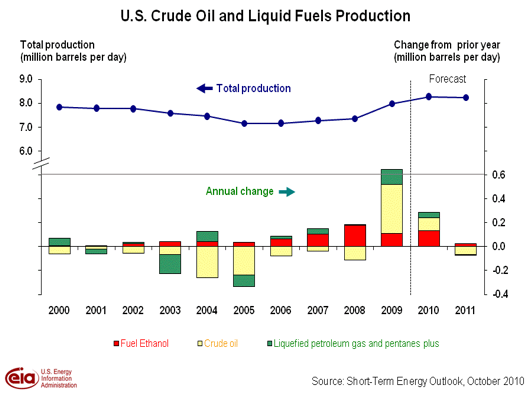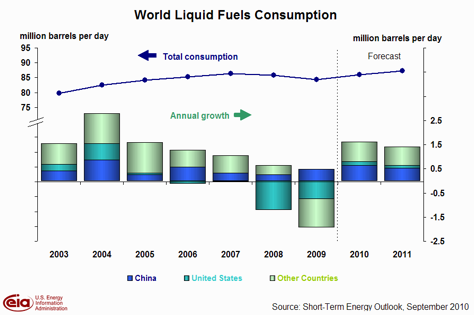Katie Howell of E&E reports: “The Obama administration is acknowledging that its new offshore drilling safety regulations will raise costs for the oil and gas industry—and may also delay some offshore development, slightly increase gas prices and kill some jobs.”[i]
The outlook for U.S. crude oil production for 2011 is not very positive, according to government forecasters. In 2009, the U.S. had the largest domestic production increase in the world, but that rank fell in 2010 and is expected to fall further in 2011 with a decline in offshore oil production, partly due to the moratorium on offshore drilling. In fact, the International Energy Agency is advising that any delays to offshore oil drilling could have a significant impact on future oil markets. Their advisory came when the U.S. Department of Interior (DOI) removed the drilling moratorium in place since the BP oil spill in April and when the U.S. DOI issued new rules for offshore drilling. Those new rules are expected to raise the cost of drilling offshore, create delays in obtaining permits, and thus decrease oil production, even putting some small U.S. oil companies out of the offshore market. The result, of course, means more reliance on crude oil imports, most likely from OPEC, and fewer U.S. jobs, a much needed commodity.
The New Offshore Drilling Rules
The new rules require additional testing of critical safety equipment and multiple barriers at offshore wells to prevent the escape of hydrocarbons, resulting in higher drilling costs.[ii] According to government estimates, an annual price tag of $183 million is expected.[iii] That price tag is composed of the following increases[iv]:
- An additional $1.42 million for drilling a deepwater well with a floating rig. Current estimates are $90 t0 $100 million.
- An additional $170,000 for drilling a deepwater well with a platform rig.
- An additional $90,000 for drilling a shallow-water well.
Since the government estimates that another oil spill like the April BP spill would cost $16.3 billion[v], it believes the additional cost for safety and prevention is worth the expense, since it represents less than a 2 percent increase for deepwater wells and about a one percent increase for shallow wells. The DOI also recognizes that the new rules will add to the time to drill deepwater wells and reduce investment in domestic oil and gas resources, causing more job losses and even some small oil and gas companies going under. Job losses could result at over 130 companies that own active leases in federal waters and over a dozen drilling contractors.[vi] A recent study conducted by Joseph R. Mason of Louisiana State University calculates the job losses of a six-month moratorium at 12,046; lost wages at $707 million; lost federal tax revenues at $219 million; and lost output at almost $2.8 billion.[vii]
DOI believes that the increased costs will not result in higher bills for consumers since there are adequate global supplies to offset the anticipated decrease in domestic production.[viii] In this case, apparently, the DOI has little concern for increasing our dependence on foreign sources of oil[ix], nor do they feel threatened by having to compete with China’s growing oil consumption and investment in foreign oil supplies.
The Oil Forecasts
The Energy Information Administration (EIA) forecasts in its Short-Term Energy Outlook[x] that domestic crude oil production in 2010 will increase by only one-fourth of its 2009 increase, and then decline in 2011. In 2009, U.S. oil production increased by 410,000 barrels per day, and it is expected to increase by only 100,000 barrels per day in 2010, followed by a drop of 60,000 barrels per day in 2011. The decline of 170,000 barrels per day of oil production in the Federal Gulf of Mexico in 2011 is partially made up by an increase of 130,000 barrels per day in onshore production in the lower 48 states. Of the 170,000 barrels per day production decline in Gulf of Mexico waters, 82,000 barrels per day is due to the moratorium, according to EIA Administrator, Richard Newell.[xi] The EIA Administrator also indicated that it could take two years for Gulf production to return to pre-drilling ban levels due to the time lag between drilling and production.[xii]
EIA is predicting that both crude oil prices and gasoline prices will increase next year. The agency forecasts that the price of West Texas Intermediate crude will average $78 per barrel in 2010 and $83 per barrel in 2011, compared to 2009 prices at $62 per barrel. They predict that regular grade gasoline prices will average $2.74 per gallon in 2010 and $2.92 per gallon in 2011, a seven percent increase. Gasoline prices averaged only $2.35 per gallon in 2009.[xiii]
According to the International Energy Agency (IEA), delays of any kind to offshore deepwater drilling could have a significant impact on oil markets.[xiv] Currently, a third of the world’s oil production currently comes from offshore oil fields, and that figure is expected to increase to one-half by 2015. IEA also warns that China has surpassed the United States in total energy consumption last year and that the country’s appetite for oil seems insatiable with about half of the world’s oil demand increase coming from that country. EIA sees China demanding 40 percent of the increase in the world’s expected oil consumption.[xv] (See figure below.) Since OPEC is the source of over a third of the world’s oil supplies, any reduction in offshore drilling will result in even greater reliance on oil from OPEC, who has learned to control the market price with production quotas.
Conclusion
The Obama Administration has announced the end to the offshore oil drilling moratorium, just in time for the mid-term elections. However, the new rules developed by the U.S. DOI for improving safety and decreasing the probability of another major oil spill will result in continued delays in permitting and increased costs to industry. While the Obama Administration has not been able to calculate the benefits of the new rules, they believe the one or two percent increase in the cost of drilling warrants the changes.
Although not part of the deepwater moratorium, new rules were also developed for shallow water drilling, which resulted in a major slow-down of those permits. Only four out of 10 shallow-water drilling applications were approved between June and August while all 15 applications were approved during the same period last year.[xvi] According to Director Bromwich, Bureau of Ocean Energy Management, DOI, 20 staffers have been reassigned from Alaska and California to deal with the backlog in permits in the Gulf of Mexico,[xvii] recently approving 12 new shallow water permit applications using the new rules.
But those 20 people will probably make little progress in moving deepwater permits because of the onslaught of new applications that will have to be matched to the tighter rules. As such, the United States will see production declines in offshore oil, job losses, and a greater reliance on foreign oil sources, in which we will have to compete with China, who is already investing heavily in foreign oil fields to meet its soaring demand.
[i] The Foundry, Obama Administration Admits New Drilling Rules Will Kill Jobs, October 11, 2010, http://blog.heritage.org/2010/10/11/obama-administration-admits-new-drilling-rules-will-kill-jobs/
[ii] Houston Chronicle, Price tag for drilling rules put at $183 million a year, October 8, 2010, http://www.chron.com/disp/story.mpl/business/7239139.html
[iii] Federal Register, Oil and Gas and Sulphur Operations in the Outer Continental Shelf-Increased Safety Measures for Energy Development on the Outer Continental Shelf, October 14, 2010, http://www.federalregister.gov/articles/2010/10/14/2010-25256/oil-and-gas-and-sulphur-operations-in-the-outer-continental-shelfincreased-safety-measures-for
[iv] Ibid.
[v] Ibid.
[vi] The Foundry, Obama Administration Admits New Drilling Rules Will Kill Jobs, October 11, 2010, http://blog.heritage.org/2010/10/11/obama-administration-admits-new-drilling-rules-will-kill-jobs/
[vii] The Economic Cost of a Moratorium on Offshore Oil and Gas Exploration to the Gulf Region, Joseph R. Mason, July 2010, https://www.instituteforenergyresearch.org/wp-content/uploads/2010/07/Mason-Economic_Cost_of_Offshore_Moratorium.pdf
[viii] Houma Today, New rules make deepwater oil drilling more expensive, October 11, 2010, http://www.houmatoday.com/article/20101011/ARTICLES/101019985/-1/opinion?p=3&tc=pg
[ix] The Obama Administration has used national security and oil independence as a reason for cap-and-trade legislation to reduce greenhouse gases and for supporting investments in wind and solar energy,
[x] Energy Information Administration, Short-Term Energy Outlook, October 13, 2010, http://www.eia.doe.gov/emeu/steo/pub/contents.html
[xi] Reuters, UPDATE 1-EIA says ending drilling ban won’t impact its forecast, October 13, 2010, http://www.reuters.com/article/idUSN1325352020101013
[xii] Ibid.
[xiii] Energy Information Administration, Short-Term Energy Outlook, October 13, 2010, http://www.eia.doe.gov/emeu/steo/pub/contents.html
[xiv] Reuters, UPDATE 1-Offshore drilling delays could hit oil market-IEA, October 12, 2010, http://af.reuters.com/article/energyOilNews/idAFLDE69B18620101012?pageNumber=3&virtualBrandChannel=0
[xv] Energy Information Administration, Short-Term Energy Outlook, October 13, 2010, http://www.eia.doe.gov/emeu/steo/pub/contents.html
[xvi] CNSNEWS, New Rules Slow Gulf Drilling in Shallow Water, September 14, 2010, http://www.cnsnews.com/news/article/75264
[xvii] Energy Guardian, October 13, 2010





